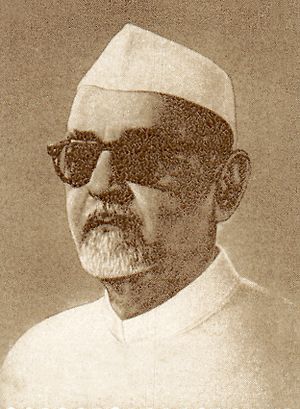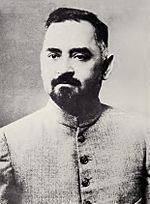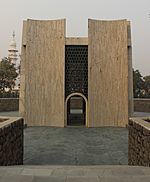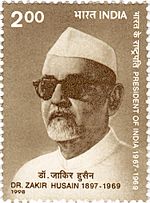Zakir Husain (politician) facts for kids
Quick facts for kids
Zakir Husain
|
|
|---|---|

Husain's portrait on a 1998 post stamp of India
|
|
| 3rd President of India | |
| In office 13 May 1967 – 3 May 1969 |
|
| Prime Minister | Indira Gandhi |
| Vice President | Varahagiri Venkata Giri |
| Preceded by | Sarvepalli Radhakrishnan |
| Succeeded by | Varahagiri Venkata Giri (acting) |
| 2nd Vice President of India | |
| In office 13 May 1962 – 13 May 1967 |
|
| President | Sarvepalli Radhakrishnan |
| Prime Minister | Jawaharlal Nehru Lal Bahadur Shastri Indira Gandhi |
| Preceded by | Sarvepalli Radhakrishnan |
| Succeeded by | Varahagiri Venkata Giri |
| 4th Governor of Bihar | |
| In office 6 July 1957 – 11 May 1962 |
|
| Chief Minister | Krishna Sinha Deep Narayan Singh |
| Preceded by | R. R. Diwakar |
| Succeeded by | Madabhushi Ananthasayanam Ayyangar |
| Member of Parliament, Rajya Sabha (nominated) |
|
| In office 3 April 1952 – 6 July 1957 |
|
| Personal details | |
| Born | 8 February 1897 Hyderabad, Hyderabad State, British India (present-day Telangana, India) |
| Died | 3 May 1969 (aged 72) New Delhi, India |
| Cause of death | Heart attack |
| Political party | Independent |
| Spouse | Shah Jahan Begum |
| Children | 2 |
| Alma mater | University of Lucknow Mohammedan Anglo-Oriental College Aligarh (MA) University of Berlin (PhD) |
| Profession | |
| Awards | Bharat Ratna (1963) Padma Vibhushan (1954) |
Zakir Husain Khan (born February 8, 1897 – died May 3, 1969), known as Dr. Zakir Husain, was an important Indian educator and politician. He served as the third President of India from May 13, 1967, until his death in 1969.
Born into an Afridi Pashtun family in Hyderabad, Husain studied in various places, including Aligarh and the University of Berlin. He earned a doctorate degree in economics from Berlin. He was one of the people who helped start the Jamia Millia Islamia university. He worked there as its Vice-Chancellor from 1926 to 1948.
Dr. Husain worked closely with Mahatma Gandhi on education. He led a committee that created a new education plan called Nai Talim. This plan focused on free and required education in a child's first language. He also became the Vice-Chancellor of Aligarh Muslim University in 1948. He helped it become a major national university.
For his work in education, he received the Padma Vibhushan award in 1954. He was also a member of the Indian Parliament from 1952 to 1957. Husain served as the Governor of Bihar from 1957 to 1962. Then, he was elected the Vice President of India in 1962. The next year, he received India's highest civilian award, the Bharat Ratna.
He was elected President in 1967, following Dr. S. Radhakrishnan. He became the first Muslim to hold this high office in India. He was also the first President to die while in office in 1969. His time as President was the shortest of any President. His tomb is located on the campus of Jamia Millia Islamia in Delhi.
Zakir Husain was also an author and translated several books into Urdu. He wrote many children's books. India has honored him with postage stamps and by naming many educational institutions, libraries, roads, and even Asia's largest rose garden after him.
Contents
Early Life & Education
Husain was born in Hyderabad in 1897. His family had Afridi Pashtun roots. His ancestors had settled in Qaimganj in Uttar Pradesh. His father, Fida Husain Khan, moved to Hyderabad and became a successful lawyer.
Zakir Husain was the third of seven sons. He was taught at home in Quran, Persian, and Urdu. He likely had his primary education at the Sultan Bazaar school in Hyderabad. After his father died in 1907, his family moved back to Qaimganj. He then went to Islamia High School in Etawah.
In 1911, Husain's mother and other family members died in a plague epidemic. He finished school in 1913 and joined the Muhammadan Anglo-Oriental College at Aligarh. Later, he studied for a science degree at Lucknow Christian College. He had to stop studying due to illness.
A year later, he rejoined the college at Aligarh. Husain graduated in 1918, studying philosophy, English literature, and economics. He was chosen as vice president of the college's student union. He also won awards for his debating skills. He continued his studies in law and economics. After getting his master's degree in 1920, he became a lecturer at the college.
Family Life & Connections
Zakir Husain had six brothers. One brother, Yusuf Husain, became a historian and won an award. Another brother, Mahmud Husain, was involved in the creation of Pakistan. He became the Minister of Education in Pakistan.
In 1915, while still in college, Husain married Shahjahan Begum. They had two daughters, Sayeeda Khan and Safia Rahman. Their grandson, Salman Khurshid, later became India's External Affairs Minister in 2012.
Career Highlights
Leading Jamia Millia Islamia (1926-1948)
In 1920, Mahatma Gandhi visited the Muhammadan Anglo-Oriental College. He asked people to stop cooperating with the British Raj. Because of this, some students and teachers started the Independent National University. This university aimed to provide education without British influence. It was later named Jamia Millia Islamia.
Husain was one of the founders of this university. It moved from Aligarh to Delhi in 1925. Jamia faced money problems in its early years. Its future was uncertain, especially after some political movements ended.
Husain went to Germany in 1922 to get his doctorate in economics. He studied at the University of Berlin. His thesis on farming in British India was highly praised in 1926. While in Berlin, Husain helped translate 33 of Gandhi's speeches into German. He also published some poetry collections.
He returned to India in 1926 and became the Vice-Chancellor of Jamia. He traveled across India to raise money for the university. He received financial help from Mahatma Gandhi and other important people.
In 1928, a National Education Society was formed to run Jamia. Zakir Husain became its secretary. The university's rules said it would not accept help from the British government. It also said it would treat all religions fairly. Husain believed Jamia's goal was to keep Islamic culture alive. It also aimed to help create a united nation and achieve India's freedom.
Husain remained Jamia's Vice-Chancellor until 1948. He was against the idea of separate elections for Muslims. He disagreed with Muhammad Ali Jinnah, the leader of the Muslim League. However, Husain convinced Jinnah to attend Jamia's 25th anniversary in 1946. This event brought together leaders from both the Muslim League and the Congress party.
Basic National Education Plan (1937)
In October 1937, a conference was held to create a plan for basic education in India. This conference was led by Mahatma Gandhi. They formed a committee chaired by Husain, known as the Zakir Husain committee. This committee was asked to create a detailed plan for this new education policy.
The committee presented its report in December 1937. This plan was called the Wardha Scheme of Basic National Education, or Nai Talim. It suggested teaching craft work in schools. It also aimed to teach good citizenship. The plan proposed seven years of free and required basic education in a child's mother tongue. It also suggested teaching crafts, music, and drawing.
The Congress party accepted this plan in 1938. They tried to put it into action across the country. An All-India Education Board was set up to carry out the plan. Husain was its president from 1938 to 1950. The Muslim League strongly opposed this plan. They believed it was an attempt to harm Muslim culture in India.
India's later education policies, like those in 1968, 1988, and 2020, used ideas from the Wardha Scheme.
After India was divided in 1947, Husain almost died in violence at a railway station. When he returned to Delhi, he helped people affected by the riots. Jamia Milia Islamia's buildings were looted and destroyed during this violence.
Leading Aligarh Muslim University (1948-1956)
Husain became the Vice-Chancellor of Aligarh Muslim University in 1948. This university had been closely linked to the movement for Pakistan. It was seen as a place with strong pro-Pakistan feelings. The Education Minister asked Husain to lead the university. His goal was to keep it as a national institution for higher learning.
Husain started working to separate the university from its past political ties. He also worked to bring back school discipline. He allowed students involved in communist activities to return. He also hired many excellent teachers.
In 1951, a law was passed that made Aligarh Muslim University a government institution. This gave the university stable money and allowed it to govern itself. By the end of his time there, Husain had greatly improved the university. He helped it become a strong national institution.
Husain was a nominated member of the Rajya Sabha (a part of India's Parliament) from 1952 to 1957. He received the Padma Vibhushan award in 1954 for his work in culture and education. He also worked with various education organizations during the 1950s. He was part of the executive board of UNESCO from 1957 to 1958.
Governor of Bihar (1957-1962)
Husain served as the Governor of Bihar from 1957 to 1962. As Governor, he was also the Chancellor of Patna University. He reappointed the Vice-Chancellor of Patna University for a second term. The state government wanted to change the law so the Chief Minister could advise the Governor on such appointments. However, Husain threatened to resign if they did this. This made the government drop its plans.
Vice President of India (1962-1967)
On April 14, 1962, the Congress party chose Husain as their candidate for Vice President. The election was held on May 7, 1962. Husain won with 568 out of 596 votes. He was sworn in as Vice President on May 13, 1962.
In 1962, Husain was also named Vice President of the Sahitya Akademi. This is a national academy of letters in India. The next year, he received the Bharat Ratna, India's highest civilian award. In 1965, he briefly served as acting president. This happened when President Radhakrishnan went to the United Kingdom for medical treatment.
President of India (1967-1969)
Husain was chosen as the Congress party's candidate for President in 1967. He was to follow Dr. Sarvepalli Radhakrishnan. Prime Minister Indira Gandhi chose him despite some objections from other party leaders. Seven opposition parties chose the Chief Justice of India, Koka Subbarao, to run against him.
The 1967 presidential election was a real competition. There were accusations of religious bias against Husain. Some people thought he might lose, which would have made the Prime Minister resign.
The election was held on May 6, 1967, with 17 candidates. Husain won with 471,244 votes, while Subbarao received 363,971 votes. Husain's victory was larger than expected. He won the most votes in Parliament and in twelve state legislatures. His election was seen as a way for the Congress Party to connect with Muslims in India. It also showed India as a secular nation to the world.
Husain was sworn in as President on May 13, 1967. He was the first Muslim and the first state governor to become President of India. A challenge to his election was dismissed by the Supreme Court of India.
During his time as President, Husain visited countries like Canada, Hungary, Yugoslavia, USSR, and Nepal. He was very interested in roses. He is known for bringing new varieties to the Mughal Gardens at the Rashtrapati Bhavan (President's House). He also built a glass conservatory for his collection of succulent plants.
Death & Funeral
Husain had a mild heart attack earlier in 1969. He became unwell after returning from a trip to Assam on April 26, 1969. He died at the Rashtrapati Bhavan on May 3, 1969, from a heart attack. Vice President V. V. Giri became acting president that same day.
The Indian government declared thirteen days of national mourning. His body was placed in the Durbar Hall of the Rashtrapati Bhavan. About 200,000 people came to pay their respects. The funeral was held on May 5, 1969. He was buried on the campus of Jamia Milia Islamia. His body was taken in a ceremonial funeral procession after prayers and a national salute.
Husain's death was also mourned in Pakistan. Flags flew at half mast there. Leaders from Pakistan, the United States, the Soviet Union, Yugoslavia, Afghanistan, and Nepal attended the funeral. Up to a million people are thought to have lined the streets for the funeral procession. Husain was the first President to die while in office. He also served the shortest time as President.
His Tomb
Husain's tomb was built in 1971. Its design mixes modern and traditional Indian styles. It has eight curved, concrete walls with marble tops. These walls are inspired by old tombs. The tomb has an open structure with a shallow dome. It has no fancy decorations but features jalis (carved screens) and arches. Husain and his wife are buried under the dome of the tomb.
Author & Writer
Husain wrote many books in Urdu. He also translated several books into Urdu. His translations include important works on economics and philosophy. He wrote a lot about education in books like Aala Taleem and Qaumi Taleem. He also wrote about Urdu poets like Altaf Hussain Hali and Mirza Ghalib.
Husain wrote many stories for children. He published these under a different name. Some of these stories were translated into English. His lectures on capitalism were published as Capitalism: An Essay in Understanding. As President, Husain led a committee to celebrate the 100th anniversary of Ghalib's birth. He also opened the Ghalib Academy in Delhi in 1969.
Remembering Zakir Husain
India Post issued special postage stamps honoring Husain in 1969 and 1998. A documentary film about his life was made in 1969.
Many places are named after him. In 1975, Delhi College was renamed the Zakir Hussain College. The Zakir Husain Centre for Educational Studies at Jawaharlal Nehru University is also named after him. The Dr. Zakir Husain Central Library at Jamia Milia Islamia bears his name. Delhi's Wellesley Road was renamed Dr. Zakir Hussain Marg. The Zakir Hussain Rose Garden in Chandigarh, which is Asia's largest rose garden, is also named after him. A book about him, Dr. Zakir Hussain - Teacher who became President, was released in 2000.
Images for kids
See also
 In Spanish: Zakir Husain para niños
In Spanish: Zakir Husain para niños










